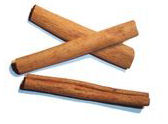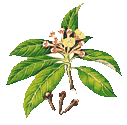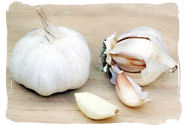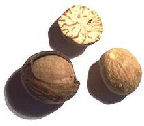The Foods
Sugar & Spice
There are many foods on Gor that are similar or the same to those found on Earth. Many of the foods originated from Earth. However, there are great differences as well, even amongst those products of Earth origin. It is safe to assume that spices common to Earth are also common to Gor. Here are a few of those mentioned in the Gorean world. Some spices, as indicated by the following quotes, can be quite hot to eat.
"Some of the peppers and spices, relished even by children in the Tharai districts, were sufficient to convince an average good fellow of Thentis or Ar that the roof of his mouth and his tongue were being torn out of his head." — Tribesmen of Gor, page 46.
"… the small bowls of spices and sugars with their stirring spoons at hand." — Nomads of Gor, page 253.
Cinnamon
A sweet spice which is a main export of the Schendi region.  Cinnamon is one of the oldest spices known on Earth. It was mentioned in the Bible and was used in ancient Egypt not only as a beverage flavoring and medicine, but also as an embalming agent. It was so highly treasured that it was considered more precious than gold. Around this time, cinnamon also received much attention in China, which is reflected in its mention in one of the earliest books on Chinese botanical medicine, dated around 2,700 B.C.
Cinnamon is one of the oldest spices known on Earth. It was mentioned in the Bible and was used in ancient Egypt not only as a beverage flavoring and medicine, but also as an embalming agent. It was so highly treasured that it was considered more precious than gold. Around this time, cinnamon also received much attention in China, which is reflected in its mention in one of the earliest books on Chinese botanical medicine, dated around 2,700 B.C.
"Yes," I said. "It is cinnamon and cloves, is it not?"
"Yes," said Ulafi, "and other spices, as well." — Explorers of Gor, page 98.
Cloves
Great spice for baking with.  One of the main trading goods of the Schendi. Cloves can be used in cooking either whole or in a ground form, but as they are extremely strong, they are used sparingly.
One of the main trading goods of the Schendi. Cloves can be used in cooking either whole or in a ground form, but as they are extremely strong, they are used sparingly.
"Yes," I said. "It is cinnamon and cloves, is it not?""Yes," said Ulafi, "and other spices, as well." — Explorers of Gor, page 98.
Garlic
Great for Warriors' blood pressure.  Garlic is widely used for its pungent flavor, as a seasoning or condiment or to enhance other flavors. Depending on the form of cooking and the desired result, the flavor is either mellow or intense.
Garlic is widely used for its pungent flavor, as a seasoning or condiment or to enhance other flavors. Depending on the form of cooking and the desired result, the flavor is either mellow or intense.
"I have peas and turnips, garlic and onions in my hut." — Outlaw of Gor, page 29.
Honey
That sweet product of bees.
"The proprietor arrived with hot bread, honey, salt and, to my delight, a huge, hot roasted
chunk of tarsk." — Outlaw of Gor, page 79.
"Merchants brought sides of bosk, and thighs of tarsk, and wines and fruits to camp, and cheeses and breads and nuts, and flowers and candies and silks and honeys." — Captive of Gor, page 321.
"I saw small fruit trees, and hives, where honey bees were raised…" — Marauders of Gor, page 81.
"I had had verr meat, cut in chunks and threaded on a metal rod, with slices of peppers and larma, and roasted; vulo stew with raisins, nuts, onions and honey; a Kort with melted cheese and nutmeg; hot Bazi tea, sugared, and, later, Turian wine." — Tribesmen of Gor, pages 47-48.
Nutmeg
Sweet spice. Nutmeg is the actual seed of the tree, roughly egg-shaped and about 20-30 mm long and 15-18 mm wide,  and weighing between 5 and 10 grams dried.
and weighing between 5 and 10 grams dried.
"I had had verr meat, cut in chunks and threaded on a metal rod, with slices of peppers and larma, and roasted; vulo stew with raisins, nuts, onions and honey; a Kort with melted cheese and nutmeg; hot Bazi tea, sugared, and, later, Turian wine." — Tribesmen of Gor, pages 47-48.
Salts
Although the marshlands of the Vosk delta are of both fresh and salt water, there is nothing mentioned of salt mined from this region. Most of the salt used on Gor is from the mines of Klima, located in the Tahari desert. Table salts are traded in cannisters. The Torvaldslander, however, gathers his salt from the sea. Most salt on Gor is white, however, due to ferrous oxide deposits, some salt mined at Klima is red in color; this red salt is famed, known as the Red Salt of Kasra, being named for its port of embarkation at the juncture of the Upper and Lower Fayeen. There is also mention of a yellow colored salt, but no indication of where this salt is mined or found, except that it is "from the south." It is quite possible this is how the introduction to "red and yellow sweetrocks" (although those such terms I have seen used by many as sugars) came to be, though this term is not used in the books by John Norman. Note below how this confusion may have come to pass.
Etymology: Middle English, from Old English sealt; akin to Old Frisian, Old Saxon, Old Norse, & Gothic salt, Old High German salz, Latin sal salt, Greek hals salt, sea, Armenian al salt, Sanskrit salila sea;
"A colorless or white crystalline compound NaCl consisting of sodium chloride that occurs abundantly in nature both solid in minerals (as halite) and in solution, that has various uses (as for seasoning food, preserving meat, manufacturing sodium, chlorine, and their compounds, making glass and soap, and refrigerating), that constitutes about 2.6 percent of seawater, is found in small quantities in fresh water, and is present in all animal fluids and especially in urine, that is obtained commercially from deposits in the earth or by evaporation of natural brines (as seawater), and that in the commercial form usually contains small quantities of the deliquescent salts magnesium chloride and calcium chloride that cause it to attract moisture — called also common salt." —Merriam-Webster Dictionary ©2004-2006
"It had been expected, I gathered, that I would sit at one of the two long side tables, and perhaps even below the bowls of red and yellow salt which divided these tables." — Assassin of Gor, page 86.
"… at a long, low table, above the bowls of yellow and red salt.." — Nomads of Gorpage 253.
"I had even, folded and stained from the salt of the marsh, the warrior's tunic, which had been taken from me even in the marsh, before I had been brought bound before Ho-Hak on the island." — Raiders of Gor, page 68.
"On these voyages my cargos were varied. I did not, however, in this early period, because of the cost, purchase cargos of great value. Accordingly I did not carry, in these first voyages, any abundance of precious metals or jewels; nor did I carry rugs or tapestries, or medicines, or silks or ointments, or perfumes or prize slaves, or spices or cannisters of colored table salts." — Raiders of Gor, page 138.
"Salt, incidentally, is obtained by the men of Torvaldsland, most commonly, from sea water or from the burning of seaweed. It is also, however, a trade commodity, and is sometimes taken in raids. The red and yellow salts of the south, some of which I saw on the tables, are not domestic to Torvaldsland." — Marauders of Gor, page 187.
"The red salt of Kasra, so called from its port of embarkation, was famed on Gor. It was brought from secret pits and mines, actually, deep in the interior, bound in heavy cylinders on the backs of pack kaiila." — Tribesmen of Gor, page 20.
"Most salt at Klima is white, but certain of the mines deliver red salt, red from ferrous oxide in its composition, which is called the Red Salt of Kasra, after its port of embarkation, at the juncture of the Upper and Lower Fayeen. In Gor's geologic past it seems that the salt districts, like scattered puddles of crystalline residue, are what remains of what was once an inland salt sea or several such. It may be that, in remote times, an arm of Thassa extended here, or did extend here and then, later, in seismic dislocations or continental rift became isolated from the parent body of water, leaving behind one or more smaller salt seas. Or it may be that the seas were independent, being fed by rivers, washing down accumulated salt from rocks over millions of square pasangs. It is not known. In the salt districts salt is found either in solid form or in solution. Klima, among the salt districts, is most famous for its brine pits. Salt can be found in solid form either above or below ground. With the subsidence of, the sea and the shifting of strata, certain cubic pasangs of salt, in certain areas, became pressed into granitelike formations, through which one may actually tunnel. Some of these deposits are far below the surface of the Tahari. Men live in some of them, for weeks at a time. In other areas, certain of these solid deposits are exposed and are worked rather in the manner of open mining or quarries. In places these salt mountains are more than six hundred feet high. At Klima, however, most of the salt is in solution. It is the subterranean residue of portions of the vanished seas themselves, which have slipped through fissures and, protected from the heat, and fed still by the ancient seeping rivers, now moving sluggishly beneath the surface, maintain themselves, the hidden remnants of oceans, once mighty, which long ago swelled upon the surface of Gor itself. The salt in solution is obtained in two ways, by drilling and flush mining and, in the deeper pits, by sending men below to fetch the brine. In the drilling and flush mining, two systems are used, the double-pipe system and the separate-pipe system. In the double-pipe system fresh water is forced into the cavity through an outer pipe and the heavier solution of salt and water rises bubbling through the second pipe, or inner pipe, inserted within the larger. In the separate-pipe system, two pipes, separated by several yards, are used, fresh water being forced through one, the salt water solution, the salt being dissolved in the fresh water, rising through the other. The separate-pipe system is, by most salt masters, regarded as the most efficient. An advantage of the double-pipe system is that only a single tap well need be drilled. Both systems require pumping, of course. But much of the salt at Klima comes from its famous brine pits' These pits are of two kinds, "open" and "closed." Men, in the closed pits, actually descend and, wading, or on rafts, negotiate the sludge itself, filling their vessels and later, eventually, pouring their contents into the lift sacks, on hooks, worked by windlasses from the surface. The "harvesting" vessel, not the retaining vessel, used is rather like a perforated cone with a handle, to which is attached a rope. It is dragged through the sludge and lifted, the free water running from the vessel, leaving within the sludge of salt, thence to be poured into the retaining vessels, huge, wooden tubs. The retaining vessels are then emptied later into the lift sacks, a ring on which fits over the rope hooks. In places, the "open pits," the brine pits are exposed on the surface, where they are fed by springs from the underground rivers, which prevents their dessication by evaporation, which would otherwise occur almost immediately in the Tahari temperatures. Men do not last long in the open pits. The same underground seepage which, in places, fills the brine pits, in other places, passing through salt-free strata, provides Klima with its fresh water. It has a salty taste like much of the water of the Tahari but it is completely drinkable, not having been filtered through the salt accumulations. It contains only the salt normal in Tahari drinking water. The salt in the normal Tahari fresh water, incidentally, is not without its value, for, when drunk, it helps to some extent, though it is not in itself sufficient, to prevent salt loss in animals and men through sweating. Salt, of course, like water, is essential to life. Sweating is dangerous in the Tahari. This has something to do with the normally graceful, almost languid movements of the nomads and animals of the area. The heavy garments of the Tahari, too, have as two of their main objectives the prevention of water loss, and the retention of moisture on the skin, slowing water loss by evaporation. One can permit profuse perspiration only where one has ample water and salt.
Besides the mines and pits of the salt districts, there are warehouses and offices, in which complicated records are kept, and from which shipments to the isolated, desert storage areas are arranged. There are also processing areas where the salt is freed of water and refined to various degrees of quality, through a complicated system of racks and pans, generally exposed to the sun. Slaves work at these, raking, stirring, and sifting. There are also the molding sheds where the salt is pressed into the large cylinders, such that they may be roped together and eventually he laden on pack kaiila. The salt is divided into nine qualities. Each cylinder is marked with its quality, the name of its district, and the sign of that district's salt master. Needless to say, Klima contains as well, incidental to the salt industry entered there, the ancillary supports of these mining and manufacturing endeavors, such as its kitchens and commissaries, its kennels and eating sheds, its discipline pits, its assembly areas, its smithies and shops, its quarters for guards and scribes, an infirmary for them, and so many respects Klima resembles a community, save that it differs in at least two significant respects. It contains neither children, nor women." — Tribesmen of Gor, pages 238-240."Take salt," he said. He fell to his knees, and thrust his face into the salt. He bit at the crusts. He licked crystals from them. I followed his example. We had not had salt in four days. — Tribesmen of Gor, page 234.
Sugar
Nowhere in the books of John Norman is the term "sweet rocks" used for sugar (please see the information on Salts as to how this confusion possibly came about). In certain regions, sugar is very important to the health of the people, such as in the arctic regions. The bottom passage below leaves us to believe there are four types (colors, perhaps) of sugars on Gor, however, in no other book, does this become a fact. Specifically, white and yellow are mentioned in the following passage. However, in the quote where "four Gorean sugars" is mentioned, it could also mean a measurement.
"With a tiny spoon, its tip no more than a tenth of a hort in diameter, she placed four measures of white sugar, and six of yellow in the cup." — Tribesmen of Gor, page 89.
"Lola now returned to the small table, and, kneeling head down, served us our dessert, slices of tospit, sprinkled with four Gorean sugars." — Rogue of Gor, page 132.
"… the small bowls of spices and sugars with their stirring spoons at hand." — Nomads of Gor, page 253.
"… and a tin box of yellow Turian sugar… " — Nomads of Gor, page 267.
"Hot Bazi tea I wanted. This is an important trade item in the north. I now knew why. The southern sugars are also popular. I had originally supposed this was because of their sweetness, there being few sweet items, save some berries, in the north. I now began to suspect that the calories of the sugars also played their role in their popularity. The red hunters think little of eating half a pound of sugar at a sitting." — Beasts of Gor, page 207.
![]()
Special Note
Because of the differences in publishing the books, depending upon whether published in the U.S. or Europe, depending upon whether a first publishing or a Masquerade Books release, page numbers will often vary. All of my quotes are from original, first-printing U.S. publications (see The Books page for a listing of publishers and dates) with the exception of the following books:
- Tarnsman of Gor (2nd Printing, Balantine)
- Outlaw of Gor (11th Printing, Balantine)
- Priest-Kings of Gor (2nd Printing, Balantine)
- Assassin of Gor (10th Printing, Balantine)
- Raiders of Gor (15th Printing, Balantine)
- Captive of Gor (3rd Printing, Balantine)
Disclaimer
These pages are not written for any specific home, but rather as informational pages for those not able to get ahold of the books and read them yourself. Opinions and commentaries are strictly my own personal views, therefore, if you don't like what you are reading — then don't. The information in these pages is realistic to what is found within the books. Many sites have added information, assuming the existences of certain products and practices, such as willowbark tea for healing. I've explored the books, the flora, the fauna, and the beasts, and have compiled from those mentioned, the probabilities of certain practices, and what vegetation mentioned in the books is suitable for healing purposes.